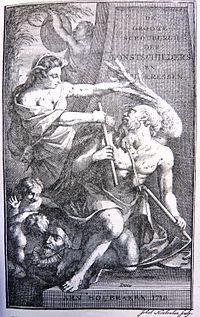The Great Theatre of Dutch Painters

Title page of the Schouburg with a portrait of Otto van Veen
|
|
| Author | Arnold Houbraken |
|---|---|
| Original title | De groote schouburgh der Nederlantsche konstschilders en schilderessen |
| Country | Netherlands |
| Language | Dutch |
| Subject | Artist biographies |
| Publisher | Arnold Houbraken |
|
Publication date
|
1718-1721 |
The Great Theatre of Dutch Painters, or De groote schouburgh der Nederlantsche konstschilders en schilderessen, as it was originally known in Dutch, is a series of artist biographies with engraved portraits written by the 18th-century painter Arnold Houbraken. It was published in three volumes as a sequel to Karel van Mander's own list of biographies known as the Schilder-boeck. The first volume appeared in 1718, and was followed by the second volume in 1719, the year Houbraken died. The third and last volume was published posthumously by Houbraken's wife and children in 1721. This work is considered to be a very important source of information on 17th-century artists of the Netherlands. The Schouburg is listed as one of the 1000 most important works in the Canon of Dutch Literature from the Middle Ages to today.
The Schouburg was not the first sequel to Karel van Mander's work. Various authors had attempted to illustrate Van Mander's work and in 1649, Jan Meyssen published Image de divers hommes in imitation of Anthony van Dyck's Iconography. Cornelis de Bie published his Het Gulden Cabinet in 1662, André Félibien published his Entretiens sur les vies et sur les ouvrages des plus excellents peintres anciens et modernes in 1666, and these were followed by Jacob von Sandrart's illustrated Teutsche Akademie in 1668. Houbraken was very familiar with Inleyding tot de Hooge Schoole der Schilderkonst, 1678, published by his teacher Samuel van Hoogstraten for students of art. Roger de Piles published L'Abrégé de la vie des peintres in the 1690s followed by Florent le Comte with his Cabinet des singularitez in 1699. As a gifted engraver, Houbraken wished to correct mistakes and omissions in these earlier works, while updating biographies with engraved portraits of artists. All of these works were used as sources for Houbraken and he mentions them in the first chapter of his first volume.
...
Wikipedia
